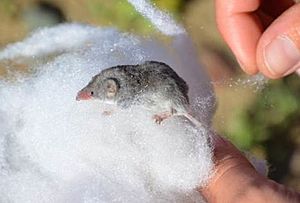Crawford's gray shrew facts for kids
Quick facts for kids Crawford's gray shrew |
|
|---|---|
 |
|
| Conservation status | |
| Scientific classification | |
| Genus: |
Notiosorex
|
| Species: |
crawfordi
|
 |
|
| Crawford's gray shrew range | |
The Crawford's gray shrew (Notiosorex crawfordi), also called the desert shrew, is a tiny mammal. It lives in the hot, dry areas of the southwestern United States and northern Mexico. This little creature belongs to a group of mammals called shrews.
For a long time, it was thought to be the only species in its group, Notiosorex. But then, scientists discovered three more types of shrews that are closely related. These new shrews were found in different parts of Mexico and Arizona.
Contents
Meet the Desert Shrew
The Crawford's gray shrew is one of the smallest mammals living in the desert. It's also one of the world's tiniest warm-blooded animals. When it's fully grown, it's only about 1.5 to 2 inches (3.8 to 5.1 cm) long. Half of that length is its tail! It weighs only about 3 to 5 grams (0.11 to 0.18 oz). That's about the weight of two paper clips!
Its fur is gray-brown on top and lighter gray underneath. Its long tail is also gray, but lighter on the bottom. Even though it's tiny, it has small ears that stick out a bit.
Life Cycle of a Shrew
Crawford's gray shrews are usually born during the summer. A mother shrew will have a litter of three to six babies. When they are born, the babies are pink and have no fur. They are about the size of a honeybee!
These tiny shrews grow very quickly. They reach their adult size in about four to five weeks. When they are very young, they drink their mother's milk. The mother can produce milk without needing to drink extra water herself. After two or three weeks, the mother brings food back to the nest. She will then bring it back up (regurgitate) for her babies to eat. By the time fall arrives, young shrews are ready to leave the nest and live on their own.
What Do Shrews Eat?
As adults, Crawford's gray shrews hunt their own food. They eat small lizards, tiny mice, and even scorpions. But their favorite foods are different kinds of arthropods, like insects and spiders.
These shrews have a very fast metabolism. This means their bodies burn energy very quickly. Because of this, they need to eat a lot! They can eat up to 75% of their own body weight every day. Sometimes, they even eat their full body weight in food! Eating so much can make them very warm. The heat from their bodies and the hot desert environment can make them overheat easily.
Desert Survival Skills
Most shrews live where there's plenty of water. But the Crawford's gray shrew lives in the desert, where water is scarce. So, it has developed special ways to save water.
- Finding Shelter: To stay cool and save water, they find safe places away from the harsh desert sun. They don't dig their own burrows. Instead, they build small nests inside the homes of other animals, like pack rats. They also hide under dead agave plants.
- Night Hunters: Unlike many other shrews that hunt all day and night, Crawford's gray shrews are nocturnal. This means they only hunt at night. This helps them avoid the hottest parts of the day and lose less water.
- Special Senses: These shrews don't have very good eyesight. So, they use their super sensitive ears and long noses to find prey in the dark. They can even use echolocation, like bats. They make high-pitched squeaks to locate their food.
- Food Storage: They also store food during the night. This way, they don't have to go out during the day to find more.
- Clever Hunting: To keep their prey fresh and prevent water loss, they have a unique trick. They bite off the legs of their victims and then crush the prey's head. This doesn't kill the prey but keeps it from moving, so it stays fresh for later.
How Shrews Save Water
The Crawford's gray shrew has amazing ways to reduce water loss from its body.
- Breathing: When it breathes, it warms the air it inhales to its body temperature. It also absorbs water vapor from the inside of its nose. When it breathes out, the air cools down, and water vapor condenses back onto its nasal passages. This clever system helps it keep more water than if it just breathed out warm, moist air. It also takes fewer breaths than other shrews.
- Low Metabolism: This shrew has the lowest resting metabolism of all shrew species. This means its body uses less energy when it's resting, which also helps it save water.
- Concentrated Urine: Shrews eat a lot of protein, which creates waste that needs to be removed from the body. This usually means losing a lot of water through urine. But the Crawford's gray shrew can make its urine very concentrated. It can make its urine four times more concentrated than a human's! This saves a huge amount of water.
Shrew Lifespan
Even with all these amazing adaptations for desert life, the Crawford's gray shrew doesn't live very long. Since it hunts at night, it can become prey for nocturnal hunters like snakes and owls. It can release a musky smell that makes it less appealing to some predators. Still, most Crawford's gray shrews only live for about a year in the wild.


